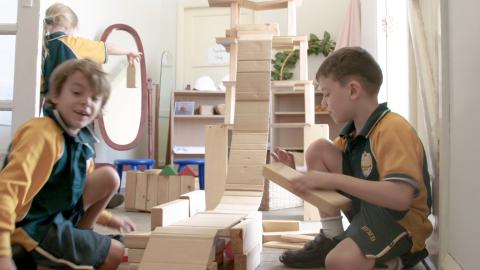Children develop numeracy and maths skills through everyday activities like counting, looking at shapes, and talking about sizes.

Curriculum
Early Years Learning Framework (ELYF)
- Children are connected with and contribute to their world
- Children are confident and involved learners
- Children are effective communicators
Measurement and space
- Sorts, describes, names and makes two-dimensional shapes, including triangles, circles, squares and rectangles. (MAE-2DS-01)
- Describes and compares areas of similar shapes. (MAE-2DS-02)
- Develops understanding and fluency in mathematics through exploring and connecting mathematical concepts, choosing and applying mathematical techniques to solve problems, and communicating their thinking and reasoning coherently and clearly. (MAE-WM-01)
National Numeracy Learning Progressions (LPs)
Families
Read (2 mins)

Children learn about 2D and 3D shapes by exploring, manipulating and describing the features of objects they see and feel.
Learning about shapes helps children identify and organise information visually, recognise signs and symbols and develop an awareness of the relationship between people, objects and the space around them.
Recognising and using shapes in the everyday and describing them, using everyday language, is foundational in developing the concepts required for measurement and geometry. Children demonstrate their growing understanding of these concepts through opportunities to organise shapes to create patterns, structures and artworks.
Learning about shapes supports children to:
- Communicate by using mathematical language to describe the different features of 2D and 3D. shapes.
- Reason in order to predict the building, stacking and organisational skills of 2D and 3D objects.
- Problem solve by using objects to determine which objects roll, slide, lay flat.
Explore (10 mins)

Some ideas for learning in the everyday:
- Identify shapes that surround you every day. Look at the bedroom and the playground. What shapes can you see?
- Look at how different shapes used together can make new shapes.
- Create a shape scavenger hunt. Use a magnifying glass to find shapes around the house or outdoors.
- Stacking shelves after grocery shopping.
- Draw, trace and cut out different shapes.
- Baking different shapes.
- Use water and a paintbrush to draw different shapes on the ground.
Teachers
Reflect (30 mins)

Reflect on your knowledge and practice. Consider the EYLF, NSW Curriculum and LPs:
- Where have these children come from?
- Where are you taking them?
Think about the learning happens in your classroom that builds the knowledge and skills for measurement and geometry.
What do you expect from the early learner?
What do you want parents to know about 2D and 3D shapes?
How is measurement and geometry used across the curriculum?
Consider this skill – What are the connections between literacy and numeracy?
This is an opportunity to share what measurement and geometry looks like in your classroom.
Engage (45 mins)

Engage in a learning conversation with parents. Suggested conversation starters:
- Is there anything in the video that challenged your thinking about learning?
- What foundational measurement and geometry skills did you see in the video?
- How are the children:
- Practising their skills?
- Testing their ideas?
- Building their knowledge?
- This is an opportunity to share what measurement and geometry looks like in your classroom.
- What opportunity can you create or do you have at home that develops measurement and geometry?